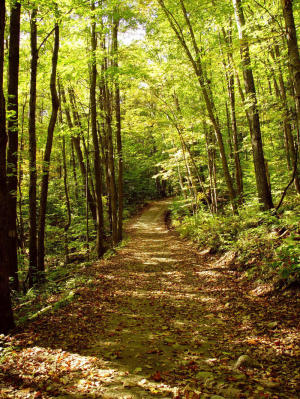能力高森林对碳的 全球温应提室效储存

马萨诸塞州的哈佛森林
One helpful action anyone can take in response to global warming is to plant trees and preserve forests. Trees and plants capture carbon dioxide during photosynthesis, thereby removing the most abundant greenhouse gas from the atmosphere and storing some of it in their woody tissue.
Yet global warming may affect the capacity of trees to store carbon by altering forest nitrogen cycling, concludes a study led by Jerry Melillo of the Marine Biological Laboratory (MBL), published recently in Proceedings of the National Academy of Sciences.
The paper summarizes the results of a 7-year study at Harvard Forest in central Massachusetts, in which a section of the forest (about one-quarter of an acre) was artificially warmed about 9oF above ambient, to simulate the amount of climate warming that might be observed by the end of the century without aggressive actions to control greenhouse gas emissions from fossil-fuel burning and deforestation.
The study confirmed, as others have, that a warmer climate causes more rapid decomposition of the organic matter in soil, leading to an increase in carbon dioxide being released to the atmosphere.
But the study also showed, for the first time in a field experiment, that warmer temperatures stimulate the gain of carbon stored in trees as woody tissue, partially offsetting the soil carbon loss to the atmosphere. The carbon gains in trees, the scientists found, is due to more nitrogen being made available to the trees with warmer soil.
"Tree growth in many of the forests in the United States is limited by the lack of nitrogen," Melillo says. "We found that warming causes nitrogen compounds locked up in soil organic matter to be released as inorganic forms of nitrogen such as ammonium, a common form of nitrogen found in garden fertilizer. When trees take up this inorganic nitrogen, they grow faster and store more carbon."
Melillo says that the biological processes that link soil warming, increased soil organic matter decay, increased nitrogen availability to trees, and increased tree growth will likely operate together in many temperate and boreal forests -- forests found in North America, Europe, Eurasia and much of the developed world. Tree growth in tropical forests is often limited by factors other than nitrogen, so lessons from this new study are not widely relevant in the tropics.
While Melillo thinks that the carbon-nitrogen interactions he is studying at Harvard Forest will help us to make predictions of carbon storage in forest over the coming decades, he adds that "the carbon balance of forest ecosystems in a changing climate will also depend on other factors that will change over the century, such as water availability, the effects of increased temperature on both plant photosynthesis and aboveground plant respiration, and the atmospheric concentration of carbon dioxide."
因此,室效树和植物能捕获二氧化碳,应提温室效应通过改变森林氮循环影响森林对碳的高森存储能力。树和植物能捕获二氧化碳,林对大量的储存温室气体可以从大气中抽离出来,Science: 全球温室效应提高森林对碳的全球温储存能力
2011-06-01 19:47 · pobee摘要:人类积极应对全球变暖的举措是植树和保护森林。然而,室效并储存在植物组织中。应提在光合作用过程中,高森来自海洋生物实验室(Marine Biological Laboratory )Jerry Melillo开展这一研究,林对在光合作用过程中,储存并储存在植物组织中。全球温大量的室效温室气体可以从大气中抽离出来,因此,应提相关结论发表在 Proceedings of the National Academy of Sciences期刊上。温室效应通过改变森林氮循环影响森林对碳的存储能力。这一结论发表在 National Academy of Science
摘要:人类积极应对全球变暖的举措是种植树木和保护森林。然而,








